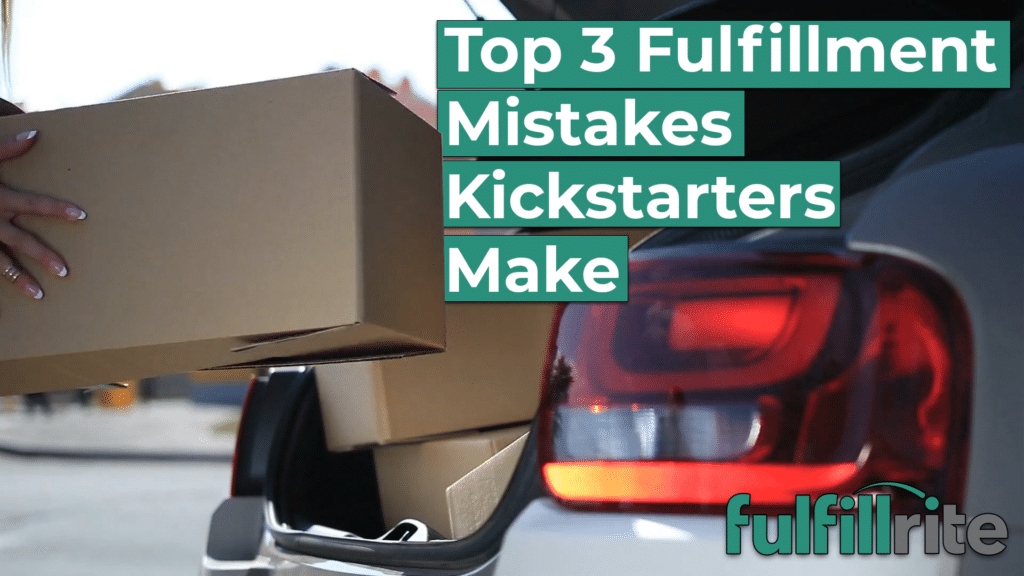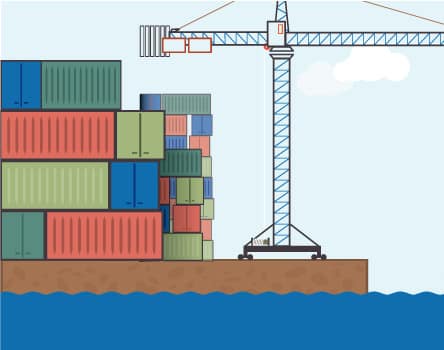This video is brought to you by Fulfillrite.
Eighty-four percent of Kickstarters ship late. Let that sink in for a minute.
As early as 2012, CNN Business was already gathering statistics on how often Kickstarters shipped on-time. The answer, even back then, was not many. This was before COVID-19 or the ongoing supply chain crises unfolding right now. Delayed Kickstarters have only become more common since then.
Kickstarter backers know this is part of the deal. You back a cool gadget or board game, knowing that you’ll probably get it 3 to 6 months after the target date. It’s a part of the culture. A subject of jokes, even!
But behind the good-natured humor, there’s a question begging to be asked: why is this so common? Some of it is bad luck, sure, and Kickstarter creators can’t control every single variable. But a lot of delays, especially prior to 2020, were preventable.
In this video, we’ll talk about the top 3 mistakes that Kickstarters make when it comes to fulfillment. With this knowledge, you can reduce the odds that your campaign suffers the same fate.
But before we get to that, a quick note. If you need help fulfilling a Kickstarter, look no further. We’ve worked with hundreds of Kickstarter campaigns, and would be happy to help you with yours too. Go to fulfillrite.com/open to request a quote today. Link in the description.
Alright, back to the show!
Top 3 Fulfillment Mistakes Kickstarters Make (And How to Avoid Them)
1. Setting unrealistic expectations.
One of the unfortunate realities of setting up a Kickstarter is that you have to enter an expected delivery date for your rewards. It makes sense, of course, because people shouldn’t be turning over money without any promise of when their rewards might arrive. Still, it requires creators to try to estimate when items will be ready to ship. And that’s really, really hard.
So what’s going on here? We know that to set backer expectations, you have to pick an estimated delivery date. Why is it so tough to estimate when rewards will be ready to ship?
The simple answer is that the supply chain is complicated. Massively, maddeningly complicated at that. The easiest way to understand it is through examples.
Kickstarter is the land of hobby board games, so let’s use a game as an example. After a Kickstarter is complete, here’s what has to happen.
Step 1. The Kickstarter payment has to clear. That takes two weeks.
Step 2. The game must be printed. Prior to COVID-19, this could take six weeks or more depending upon the complexity of the game.
Step 3. The game had to then be freight shipped to one or more warehouses across the world. Most games are shipped by sea since it’s cheaper, even now with all the disruptions we’re seeing. Prior to COVID-19, this would take around six weeks plus however much time it took to clear customs, which could be days to weeks itself.
And right now, in late 2021? You can pretty much double the printing and freight shipping time.
Step 4. The fulfillment warehouses must receive the inventory and then individually package the items to send in the mail. This could take a day or two to weeks depending on the time of year and whether or not the warehouse is backed up.
Step 5. Postal carriers must deliver the inventory to the backers, and this could take anywhere from a couple of days to a couple of weeks.
Then, finally, about 3-5% of these rewards will be lost or broken, and must be shipped out to the backer again, adding a couple more weeks to the process before it’s truly complete.
So take all these steps together and for a simple board game, you’re looking at 4-5 months between the Kickstarter’s success and delivery to backers. And this is in a best-case scenario, prior to COVID-19.
So how do you, as a Kickstarter creator, set good expectations?
First, get clear estimates for the manufacturing, freight shipping, customs clearance, and order fulfillment timetables. That way, you know what things look like for your project in a best case scenario. The more up-to-date information, the better.
Second, it’s simple, but important – pad your timetable by a month or two. Something is almost certain to go slower than expected, so make sure you don’t give your backers false hopes that everything will work out perfectly smoothly.
Last, keep an open line of communication with your backers. Even if you do all your research, you might still get unlucky. Boats get stuck in canals, goods get impounded by customs, and factory workers call out sick sometimes. If you see a supply chain hiccup coming, own it and tell your backers. The vast majority of your backers will appreciate the honesty!
2. Mismanaging freight shipping.
Freight shipping is probably the hardest part of the supply chain for Kickstarter creators. Most creators don’t have a problem understanding the need for manufacturing, and having it done well. What’s more, many creators are reading guides online and have picked up on the message that it’s good to have a company take care of order fulfillment (hence us being in business).
But freight shipping? It’s just hard to understand. It hardly ever makes the news and it’s not a flashy subject. But the vast majority of items you have in your household once sailed on a boat from one part of the world to another. Or the items contain smaller component parts that went through that journey.
So what’s so hard about freight shipping? First, there’s finding someone who can take care of it for you. Alone, it’s nearly impossible to coordinate the delivery of goods from one country – or one town – to another. You either must go through a freight broker or a marketplace such as Freightos.
Let’s talk about freight marketplaces since brokers are individuals who take care of the freight shipping for you.
When you book freight through a marketplace, you’re confronted with a bunch of questions. How heavy is the product? What’s it’s tariff code? Is it hazardous? Do you need a customs bond? Should you ship by sea or air?
All of these questions will depend heavily upon the nature of your product, and you need to figure out the answers before you even launch a campaign, as the answers will affect the quotes you receive and the timetables you will make from them.
Of particular importance will be figuring out how much tax you owe. You’ll need a special tariff code which will be used to determine how much you will need to pay to have goods imported. Depending on the code, you may need to comply with safety regulations in order to have your goods imported in the first place too!
And as if this weren’t enough, as of 2021, there’s a huge line of freight boats waiting for an open port to drop off their goods. So if you’re shipping anytime soon, you’ll need to factor that in.
So in summary, if you want to make freight shipping easy:
- Either find a freight broker you trust or a freight marketplace you like.
- Get a quote early.
- Figure out your tariff code.
- Figure out if the item is hazardous.
- Look up the customs fees and make sure you have the money set aside to pay.
- Look up all safety regulations and follow them!
3. Fulfilling a large amount of orders alone.
All freight shipments have to go somewhere. That somewhere is either going to be a warehouse / large business or your residence. Hopefully it’s not the latter, because order fulfillment is complicated!
Now one thing to get out of the way here. This video, of course, is by an order fulfillment company. We ship other people’s orders all day, everyday. So we naturally see our business in a positive light.
So let me tell you a story from me as an individual and not as someone doing a company video. In 2016, I made a card game and launched it on Kickstarter. In December of that year, I shipped out 130 rewards. It took my brother and I an entire Saturday to make it happen. It was a lot of work, but we managed.
Here’s what goes into shipping Kickstarter rewards. You first have to either have the freight shipment delivered to you, or you have to go pick up the goods. In my case, there was a warehouse 20 minutes away from my apartment, and we loaded up two cars full of about 50 boxes of card games.
We drove back, unloaded every single heavy box of games, then proceeded to pack orders to send to 130 people. Even using automation to create shipping labels, we still had to pack everything ourselves and make sure the right orders went to the right people.
Now with 130 orders, you can get away with this. With 500, even, you can get away with this. That’s a one-weekend job, for the most part.
But if you’re shipping more than that, fulfilling your own orders is a mistake for a couple of reasons.
First, and most important, if it takes more than a few days to get your orders out the door, then you are delaying how quickly rewards will be received. Even if you’re able to pack super fast, there’s only so much you can take to the post office or so much you can have UPS pick up from your home or office in a given day. There are limits to how much you can do on your own, and they are formidable ones.
Second, if you ship yourself, you save on labor, sure. But eventually, the postage costs will eat you up, and that’s not good. Fulfillment companies get deep discounts on postage rates and packing supplies, and it’s often enough to offset the cost of labor. A lot of people even save money by going through a fulfillment company, even though you wouldn’t think that would be the case!
This is especially true if you end up doing a lot of international shipping. With enough rewards, you can justify sending part of your shipment to a warehouse in the US and part to a warehouse in Europe, or to wherever you might need to send the goods. Having someone closer to your backers do the shipping cuts down on postage costs and saves your backers the hassle of being charged customs.
So, to make a long story short, if you want to avoid delays, consider hiring an order fulfillment company. If you’re shipping more than 250 orders, or if a lot of your orders are international, that’s a good sign that it’s time to hire some help.
If you’ve watched this video and you feel like you need help fulfilling your Kickstarter campaign, we’d like to help.
Fulfillrite is the most trusted name in order fulfillment. Boost customer satisfaction and scale your business faster with a logistics partner that feels like an extension of your team. Services include same-day shipping, real-time order and inventory tracking, dedicated customer service, and volume-based discounts.
Go to fulfillrite.com/open to request a quote today. Link in the description.
Thank you very much for watching this video. If you liked it, take a moment to like and subscribe to our channel. Don’t forget to ring the bell, too, so you can see videos as soon as they drop.
And now, a parting question – have you ever launched a Kickstarter? If so, how did it go? Let us know in the comments below. We’d love to hear from you!
You’ve done everything by the book. Your Kickstarter campaign is almost ready to launch.
You made a great product. Built an audience. Set up a campaign page.
But how do you ship it?
We put this checklist together to help you get started. It's free.





